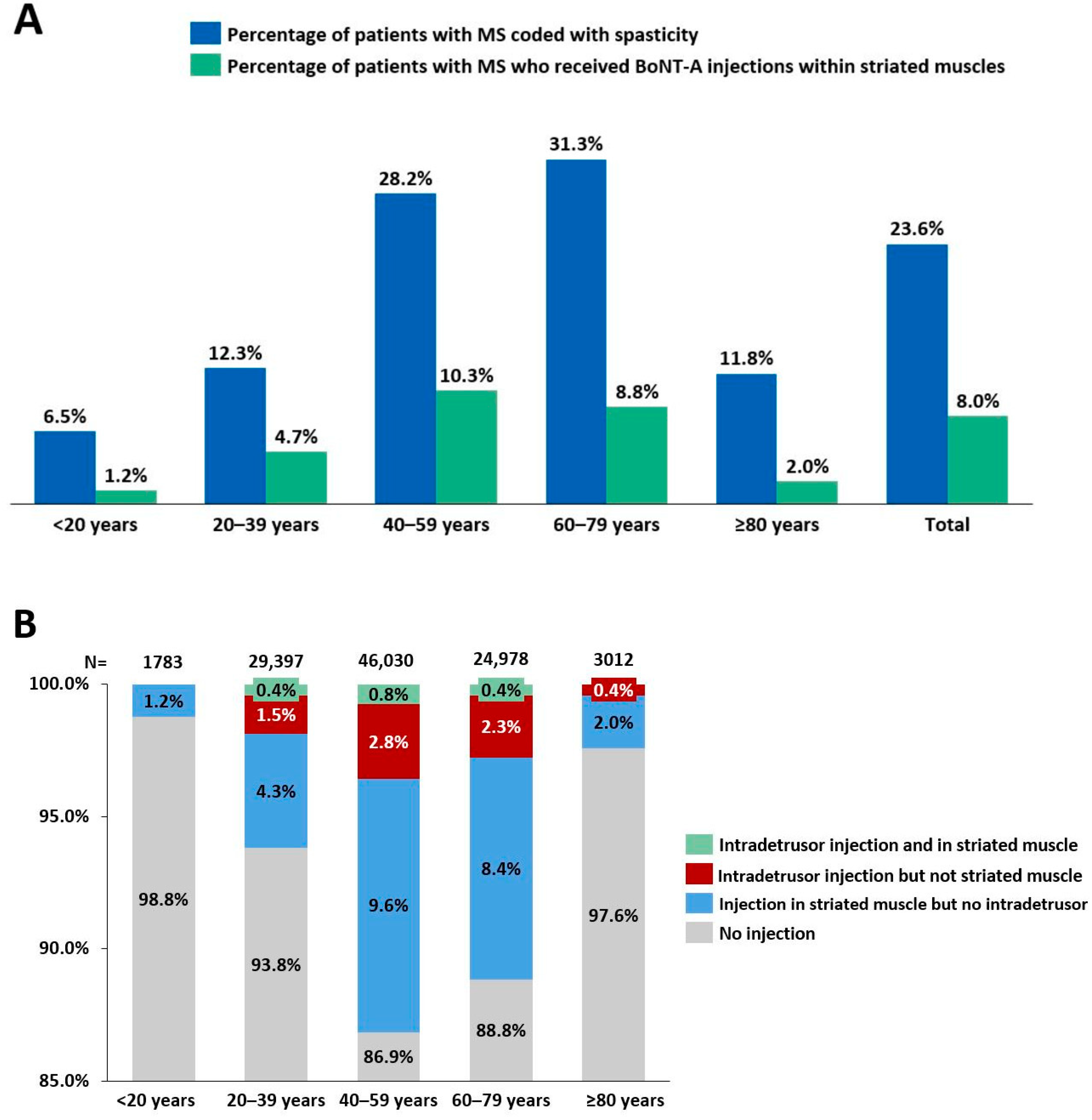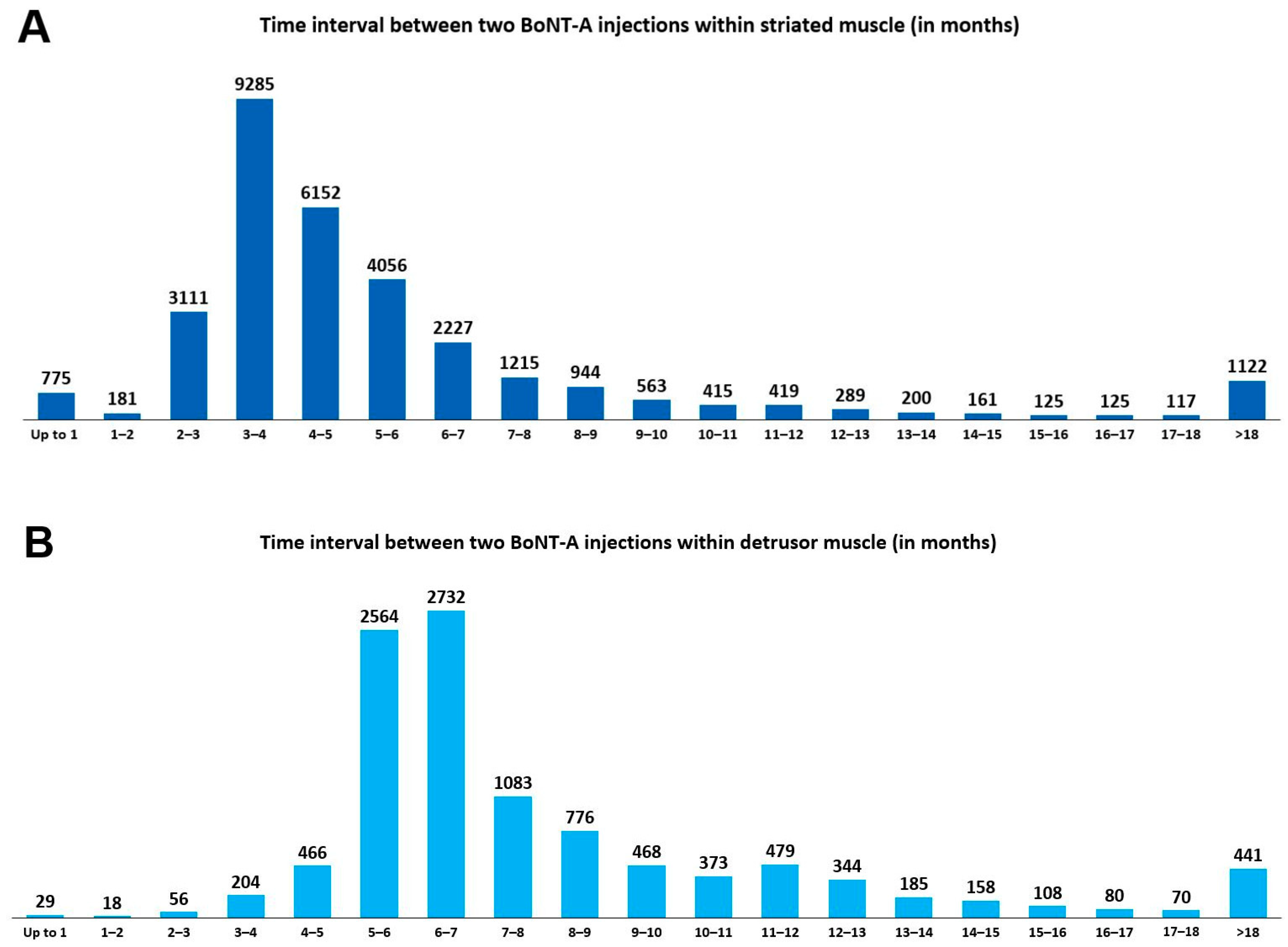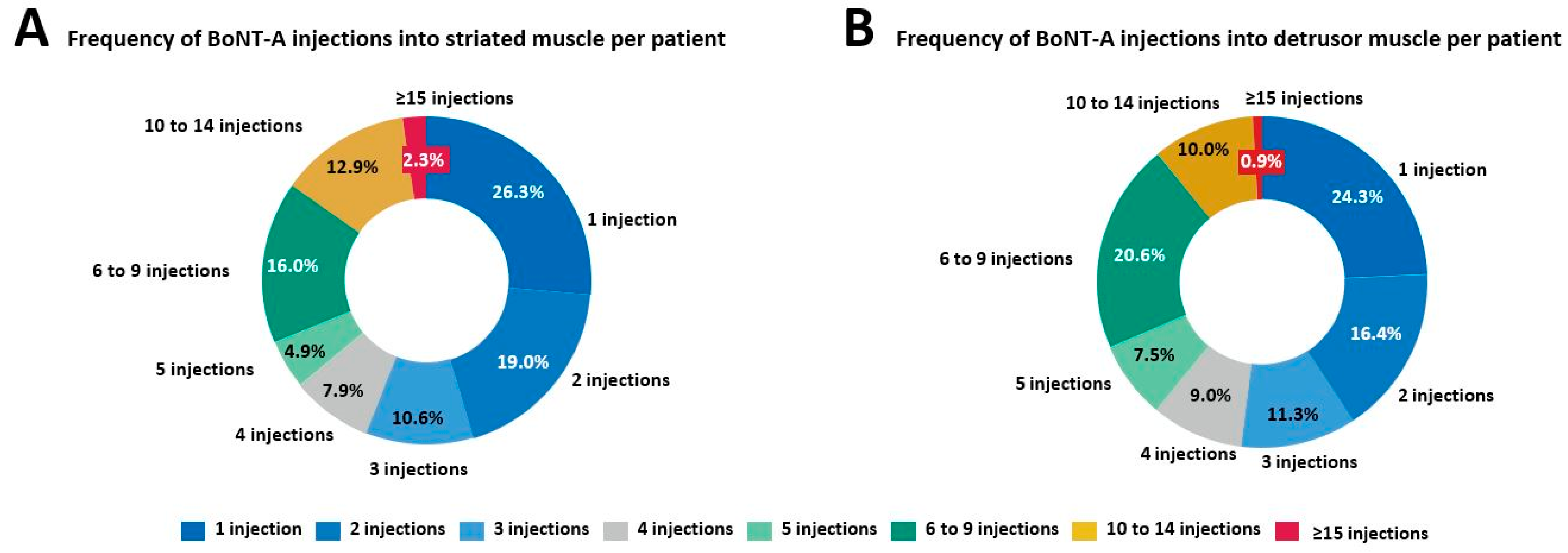Trends in Botulinum Toxin Use among Patients with Multiple Sclerosis: A Population-Based Study
Abstract
Plain Language Summary
1. Introduction
2. Results
2.1. Study Population
2.2. BoNT-A for MS-Related Spasticity
2.3. BoNT-A for Neurogenic Detrusor Overactivity
3. Discussion
4. Conclusions
5. Materials and Methods
5.1. Study Design and Data Source
5.2. Study Population and Botulinum Toxin Injections
5.3. Outcomes
5.4. Statistical Analysis
5.5. Ethics
Supplementary Materials
Author Contributions
Funding
Institutional Review Board Statement
Informed Consent Statement
Data Availability Statement
Acknowledgments
Conflicts of Interest
References
- Hui, D.; Argáez, C. Onabotulinum Toxin A (Botox) for Spasticity Associated with Multiple Sclerosis. 2021. Available online: https://www.ncbi.nlm.nih.gov/books/NBK571918/ (accessed on 20 January 2023).
- Anandan, C.; Jankovic, J. Botulinum toxin in movement disorders: An update. Toxins 2021, 13, 42. [Google Scholar] [CrossRef] [PubMed]
- Romano, M.; Bagnato, S.; Altavista, M.C.; Avanzino, L.; Belvisi, D.; Bologna, M.; Bono, F.; Carecchio, M.; Castagna, A.; Ceravolo, R.; et al. Diagnostic and therapeutic recommendations in adult dystonia: A joint document by the Italian Society of Neurology, the Italian Academy for the Study of Parkinson’s Disease and Movement Disorders, and the Italian Network on Botulinum Toxin. Neurol. Sci. 2022, 43, 6929–6945. [Google Scholar] [CrossRef] [PubMed]
- Choudhury, S.; Baker, M.R.; Chatterjee, S.; Kumar, H. Botulinum toxin: An update on pharmacology and newer products in development. Toxins 2021, 13, 58. [Google Scholar] [CrossRef] [PubMed]
- Aharony, S.M.; Lam, O.; Corcos, J. Evaluation of lower urinary tract symptoms in multiple sclerosis patients: Review of the literature and current guidelines. Can. Urol. Assoc. J. 2017, 11, 61–64. [Google Scholar] [CrossRef] [PubMed]
- Safarpour, Y.; Mousavi, T.; Jabbari, B. Botulinum toxin treatment in multiple sclerosis—A review. Curr. Treat. Options Neurol. 2017, 19, 33. [Google Scholar] [CrossRef]
- Khan, F.; Amatya, B.; Bensmail, D.; Yelnik, A. Non-pharmacological interventions for spasticity in adults: An overview of systematic reviews. Ann. Phys. Rehabil. Med. 2019, 62, 265–273. [Google Scholar] [CrossRef]
- Dressler, D.; Bhidayasiri, R.; Bohlega, S.; Chahidi, A.; Chung, T.M.; Ebke, M.; Jacinto, L.J.; Kaji, R.; Koçer, S.; Kanovsky, P.; et al. Botulinum toxin therapy for treatment of spasticity in multiple sclerosis: Review and recommendations of the IAB-Interdisciplinary Working Group for Movement Disorders task force. J. Neurol. 2017, 264, 112–120. [Google Scholar] [CrossRef]
- Comi, G.; Solari, A.; Leocani, L.; Centonze, D.; Otero-Romero, S. Italian consensus on treatment of spasticity in multiple sclerosis. Eur. J. Neurol. 2020, 27, 445–453. [Google Scholar] [CrossRef]
- French National Authority for Health (Haute Autorité de Santé). Rééducation à la Phase Chronique de l’AVC de l’Adulte: Pertinence, Indications et Modalités [Rehabilitation in the Chronic Stage after Stroke in Adults: Relevance, Indications, and Modalities]. 2022. Available online: https://www.has-sante.fr/upload/docs/application/pdf/2022-07/_reco_321_argumentaire_avc_mel_lg_v0_mg.pdf (accessed on 20 January 2023).
- Truzzi, J.C.; de Almeida, F.G.; Sacomani, C.A.; Reis, J.; Rocha, F.E.T. Neurogenic bladder—Concepts and treatment recommendations. Int. Braz. J. Urol. 2022, 48, 220–243. [Google Scholar] [CrossRef]
- Hsieh, P.F.; Chiu, H.C.; Chen, K.C.; Chang, C.H.; Chou, E.C. Botulinum toxin A for the treatment of overactive bladder. Toxins 2016, 8, 59. [Google Scholar] [CrossRef]
- Moccia, M.; Frau, J.; Carotenuto, A.; Butera, C.; Coghe, G.; Barbero, P.; Frontoni, M.; Groppo, E.; Giovannelli, M.; Del Carro, U.; et al. Botulinum toxin for the management of spasticity in multiple sclerosis: The Italian botulinum toxin network study. Neurol. Sci. 2020, 41, 2781–2792. [Google Scholar] [CrossRef] [PubMed]
- Lefeuvre, D.; Rudant, J.; Foulon, S.; Alla, F.; Weill, A. Healthcare expenditure of multiple sclerosis patients in 2013: A nationwide study based on French health administrative databases. Mult. Scler. J. Exp. Transl. Clin. 2017, 3, 2055217317730421. [Google Scholar] [CrossRef] [PubMed]
- Novarella, F.; Carotenuto, A.; Cipullo, P.; Iodice, R.; Cassano, E.; Spiezia, A.L.; Capasso, N.; Petracca, M.; Falco, F.; Iacovazzo, C.; et al. Persistence with botulinum toxin treatment for spasticity symptoms in multiple sclerosis. Toxins 2022, 14, 774. [Google Scholar] [CrossRef] [PubMed]
- Rizzo, M.A.; Hadjimichael, O.C.; Preiningerova, J.; Vollmer, T.L. Prevalence and treatment of spasticity reported by multiple sclerosis patients. Mult. Scler. 2004, 10, 589–595. [Google Scholar] [CrossRef]
- Oreja-Guevara, C.; González-Segura, D.; Vila, C. Spasticity in multiple sclerosis: Results of a patient survey. Int. J. Neurosci. 2013, 123, 400–408. [Google Scholar] [CrossRef]
- Milinis, K.; Tennant, A.; Young, C.A. Spasticity in multiple sclerosis: Associations with impairments and overall quality of life. Mult. Scler. Relat. Disord. 2016, 5, 34–39. [Google Scholar] [CrossRef]
- Chen, S.F.; Kuo, H.C. Therapeutic outcome and patient adherence to repeated onabotulinumtoxinA detrusor injections in chronic spinal cord-injured patients and neurogenic detrusor overactivity. J. Formos Med. Assoc. 2015, 114, 583–589. [Google Scholar] [CrossRef]
- Ojardias, E.; Ollier, E.; Lafaie, L.; Celarier, T.; Giraux, P.; Bertoletti, L. Time course response after single injection of botulinum toxin to treat spasticity after stroke: Systematic review with pharmacodynamic model-based meta-analysis. Ann. Phys. Rehabil. Med. 2022, 65, 101579. [Google Scholar] [CrossRef]
- Eldred-Evans, D.; Sahai, A. Medium- to long-term outcomes of botulinum toxin A for idiopathic overactive bladder. Ther. Adv. Urol. 2017, 9, 3–10. [Google Scholar] [CrossRef]
- Joussain, C.; Popoff, M.; Phé, V.; Even, A.; Bosset, P.O.; Pottier, S.; Falcou, L.; Levy, J.; Vaugier, I.; Chartier Kastler, E.; et al. Long-term outcomes and risks factors for failure of intradetrusor onabotulinumtoxin A injections for the treatment of refractory neurogenic detrusor overactivity. Neurourol. Urodyn. 2018, 37, 799–806. [Google Scholar] [CrossRef]
- Chen, S.F.; Kuo, H.C. Will repeated botulinum toxin A improve detrusor overactivity and bladder compliance in patients with chronic spinal cord injury? Tzu Chi Med. J. 2021, 33, 101–107. [Google Scholar] [CrossRef] [PubMed]
- Cheung, J.; Rancourt, A.; Di Poce, S.; Levine, A.; Hoang, J.; Ismail, F.; Boulias, C.; Phadke, C.P. Patient-identified factors that influence spasticity in people with stroke and multiple sclerosis receiving botulinum toxin injection treatments. Physiother. Can. 2015, 67, 157–166. [Google Scholar] [CrossRef] [PubMed]
- Hugos, C.L.; Cameron, M.H. Assessment and measurement of spasticity in MS: State of the evidence. Curr. Neurol. Neurosci. Rep. 2019, 19, 79. [Google Scholar] [CrossRef] [PubMed]
- Sethi, K.D.; Rodriguez, R.; Olayinka, B. Satisfaction with botulinum toxin treatment: A cross-sectional survey of patients with cervical dystonia. J. Med. Econ. 2012, 15, 419–423. [Google Scholar] [CrossRef]
- Bensmail, D.; Hanschmann, A.; Wissel, J. Satisfaction with botulinum toxin treatment in post-stroke spasticity: Results from two cross-sectional surveys (patients and physicians). J. Med. Econ. 2014, 17, 618–625. [Google Scholar] [CrossRef]
- Poliziani, M.; Koch, M.; Liu, X. Striving for more good days: Patient perspectives on botulinum toxin for the treatment of cervical dystonia. Patient Prefer. Adherence 2016, 10, 1601–1608. [Google Scholar] [CrossRef]





| First Hospitalisation for MS | Newly Treated Patients with BoNT-A | BoNT-A Treatment Initiation Rate | |
|---|---|---|---|
| 2017 | 5935 | 1064 | 17.9% |
| 2018 | 5808 | 1044 | 18.0% |
| 2019 | 5664 | 1017 | 18.0% |
| 2020 | 5019 | 858 | 17.1% |
Disclaimer/Publisher’s Note: The statements, opinions and data contained in all publications are solely those of the individual author(s) and contributor(s) and not of MDPI and/or the editor(s). MDPI and/or the editor(s) disclaim responsibility for any injury to people or property resulting from any ideas, methods, instructions or products referred to in the content. |
© 2023 by the authors. Licensee MDPI, Basel, Switzerland. This article is an open access article distributed under the terms and conditions of the Creative Commons Attribution (CC BY) license (https://creativecommons.org/licenses/by/4.0/).
Share and Cite
Bensmail, D.; Karam, P.; Forestier, A.; Loze, J.-Y.; Lévy, J. Trends in Botulinum Toxin Use among Patients with Multiple Sclerosis: A Population-Based Study. Toxins 2023, 15, 280. https://doi.org/10.3390/toxins15040280
Bensmail D, Karam P, Forestier A, Loze J-Y, Lévy J. Trends in Botulinum Toxin Use among Patients with Multiple Sclerosis: A Population-Based Study. Toxins. 2023; 15(4):280. https://doi.org/10.3390/toxins15040280
Chicago/Turabian StyleBensmail, Djamel, Pierre Karam, Anne Forestier, Jean-Yves Loze, and Jonathan Lévy. 2023. "Trends in Botulinum Toxin Use among Patients with Multiple Sclerosis: A Population-Based Study" Toxins 15, no. 4: 280. https://doi.org/10.3390/toxins15040280
APA StyleBensmail, D., Karam, P., Forestier, A., Loze, J.-Y., & Lévy, J. (2023). Trends in Botulinum Toxin Use among Patients with Multiple Sclerosis: A Population-Based Study. Toxins, 15(4), 280. https://doi.org/10.3390/toxins15040280





